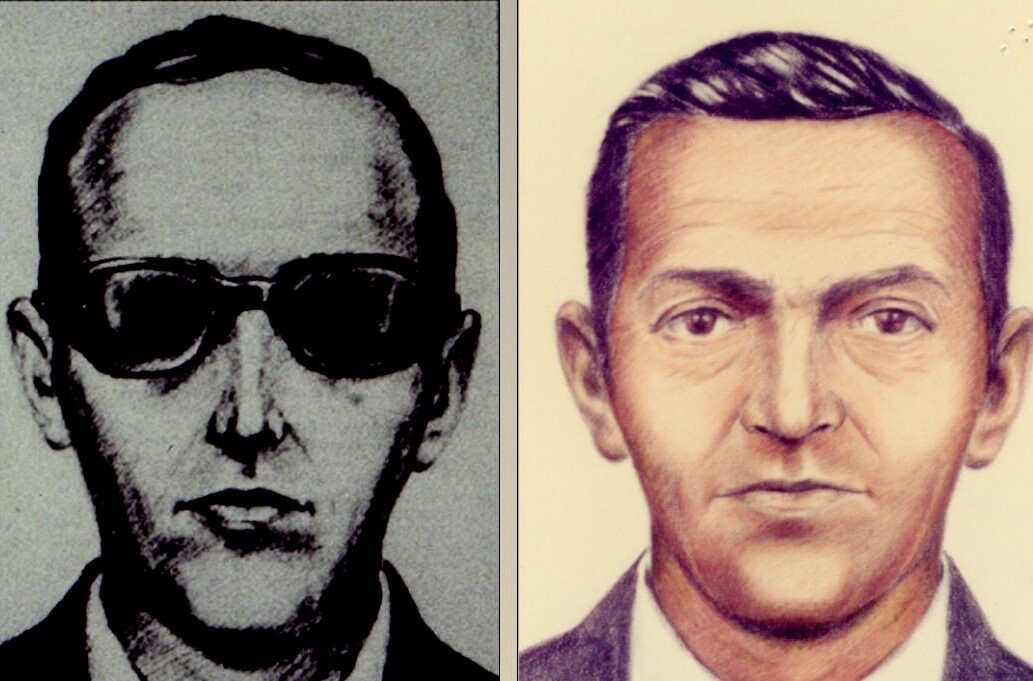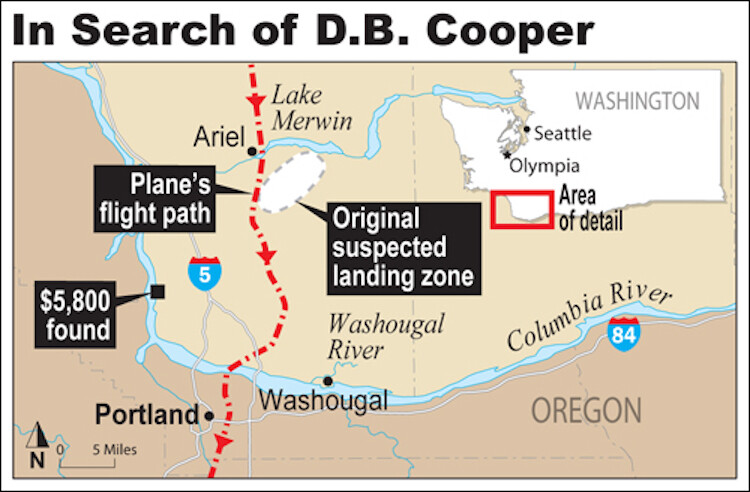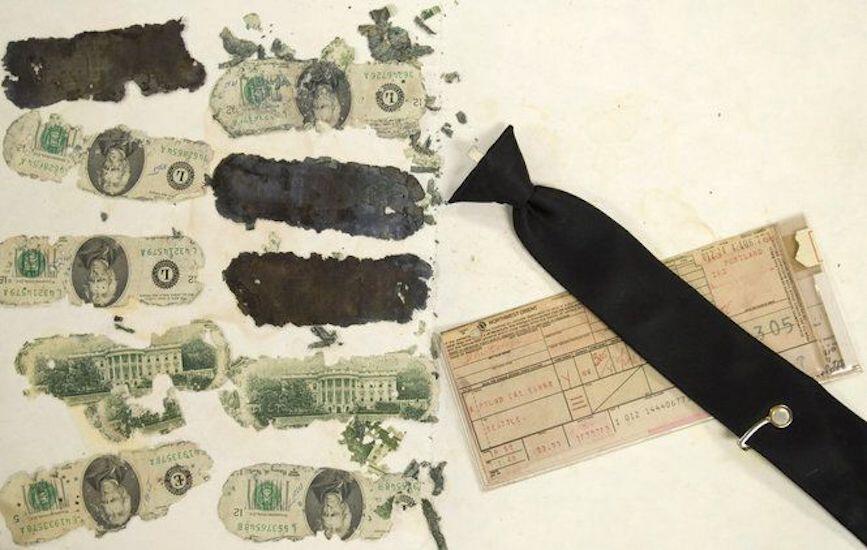On November 24, 1971, a man dubbed D.B. Cooper hijacked Northwest Orient Flight 305, heading from Portland to Seattle. After getting his ransom money, he parachuted into the cold, windy night. Although the FBI devoted massive efforts to the Northwest Hijacking (NORJAK), the mystery man evaded capture. Consequently, Cooper cemented his place in the chronicles of crime as a celebrated outlaw and the mastermind behind the only unsolved U.S. skyjacking.

FBI witness sketches of D.B. Cooper. Image: FBI.gov
Passenger in Seat 18C
The distinguished man sat alone in seat 18C on the Boeing 727 when he ordered a bourbon-soda a few minutes before take-off. As flight attendants later described him, he was a polite, chain-smoking, 40-ish gentleman. He stood at about 5′ 10 to 6′ 0″ tall with a thin build. His outfit included sunglasses and a tailored business suit, complete with a tie clip, which gave him an air of professionalism.
The man had purchased his ticket under the name “Dan Cooper.” When a newspaper later reported his name in error as “D.B. Cooper,” he acquired the moniker that’s still in use today.
Message and a Bomb
Cooper handed a piece of paper to a flight attendant. Florence Schaffner had previously received messages like this asking her for a date. Consequently, she almost dismissed the note, but the passenger insisted that she read it.
The note indicated that the man had a bomb and instructed her to sit next to him. He proceeded to open his black attaché suitcase, and she saw what appeared to be red cylinders, a battery, and some wires. To the flight attendant, it looked like a bomb.
Cooper instructed Schaffner to write down on a new piece of paper everything he was about to say to her. With the message in hand, she walked to the cockpit of the plane, where she handed Captain William Scott a ransom note demanding $200,000 (over $1.27M today) in cash and four parachutes.
Scott immediately contacted Northwest Orient Airlines and reported the incident. The company agreed to meet the ransom stipulations and stated the money would be available once they land in Seattle. Because Cooper demanded four parachutes, the authorities believed that he would take hostages. Therefore, they did not tamper with the jump equipment.
Stopover in Seattle, Tacoma
Upon landing in Seattle, Tacoma, the operations manager for Northwest Orient presented flight attendant Tina Mucklow with the $200,000 and parachutes. Once he had what he wanted, the mystery man allowed the 35 passengers and two flight attendants to deplane.
After the airplane was refueled, D.B. Cooper told the pilots they would be flying to Mexico City. However, the captain informed him that they wouldn’t be able to make it on one tank of fuel. That’s when they all agreed they would stop in Reno, Nevada.
Once the cockpit crew understood where they were headed, it was time to depart Seattle. Cooper requested that the plane take off with its rear door open and stairwell lowered, but Northwest Orient indicated that it was too dangerous. Although Cooper seemed confident that it was safe, this was not a problem for him, and the plane took off for Reno with the stairs up.
D.B. Cooper insisted that the plane travel slowly around 200 mph and never exceed 10,000 feet. The hijacker was aware that these were the minimum speed and altitude at which a 727 could fly without stalling the engine.
Because Cooper had a high level of technical expertise and know-how, investigators believed this was a man who had done this sort of thing before. Additionally, he remained calm and collected, never seeming nervous. Because of his demeanor and knowledge, the authorities theorized that he may have been an ex-army soldier with the airborne unit or perhaps even a special forces veteran.
Cooper’s Escape
Once they were in the air, D.B. Cooper told Mucklow to go to the front of the aircraft and close the curtains between First Class and Coach. She was to stay there for the remainder of the trip.

Location where D.B. Cooper may have landed and where the ransom money turned up. Image: FBI.gov.
When Northwest Orient Flight 305 landed in Reno, the pilots attempted to speak to D.B. Cooper through the public address system to get further instructions. However, there was no response. When they inspected the plane, only Cooper’s tie and two parachutes remained. Cooper, the money, and the suitcase were gone. It seemed he had lowered the stairs and jumped out of the plane somewhere between Seattle and Reno. (Other famous disappearances in history).
Discovery of the Ransom Money in 1980
Leads into the NORJAK case went quiet until 1980. On the Columbia River banks in Portland, an 8-year-old named Brian Ingram found about six thousand dollars in deteriorating twenty-dollar bills. The FBI determined that the cash originated from the ransom money given to D.B. Cooper in 1971. The original heist money had never re-entered official American circulation. More than likely, it was nowhere in the country.

Evidence: Abandoned tie and recovered money.
Even so, without the electronic systems that we have in place today, there was no way of telling whether the money was in another country’s circulation or private holding. It may have also been used in the underground criminal economy.
Although hijackings make international headlines today, between 1968 and 1972, it was so common that there was literally one every week. By far, the majority were communists or Latin-American criminals attempting to fly to Cuba. However, NORJAK was different; D.B. Cooper was actually one of the first to demand a ransom.
The incident set an important precedent for the FBI. To demonstrate to any would-be copycats that this crime would not go unpunished, the agency put a massive effort into solving it. Unfortunately, they never found their man. Then later in the seventies, there was a string of hijackers demanding ransom and diversion to exotic locations such as Algiers or even North Korea.
Who Was D.B. Cooper?
Since November 24, 1971, the FBI has investigated over 1,000 persons of interest. The assailant appeared to have experience in parachuting, possibly acquired through the military. His technical understanding seemed too developed for a civilian to pull off. Of the original list of over a thousand people, a limited number of suspects came to light.
During the investigation, the FBI made an unrelated but nevertheless startling discovery. A John Emil (going by the alias Robert P. Clark at the time) was one of the many questioned by the bureau regarding the Cooper case. During the interrogation, Emil admitted to killing his family in New Jersey some years prior. He thought this was, in fact, why he had been brought in for questioning in the first place. This closed one case but not the one the FBI had hoped.
The FBI thought they had made a break when they received a report from a woman claiming the D.B. Cooper portrait closely resembled her missing husband. Although this seemed like a promising lead, the man never turned up. With only the collaborative testimony of the family witnesses, it went cold.
Another lead was a Vietnam War veteran that, during questioning, admitted to being the assailant. However, it soon became clear this man was mentally ill and a compulsive liar. Strangely enough, there were a notable number of men coming forward throughout the investigation claiming that they were the famous hijacker.
Richard Floyd McCoy, Jr.
Two former federal agents, Russel Calame and Bernie Rhodes, wrote a book called D.B. Cooper The Real McCoy in 1991. They proposed that the Vietnam Veteran Richard McCoy, who hijacked a plane just four months after Northwest Orient’s Flight 305 incident, was really D.B. Cooper.
McCoy had served two tours in Vietnam as a helicopter pilot and received multiple awards, including a Purple Heart in 1964. He was also a skilled skydiver. When he hijacked United Flight 355, a Boeing 727 heading from New Jersey to Los Angeles, on April 7, 1972, his modus operandi was similar to that of Cooper’s.
Calame and Rhodes indicated in their book that during McCoy’s hijacking of Flight 355, his actions reflected some knowledge about the Cooper hijacking that the FBI had never revealed to the public. Therefore, they determined that he must have been D.B. Cooper and that the incident in 1972 wasn’t merely a copycat case.
Unfortunately, the FBI couldn’t prosecute McCoy for the NORJAK case because he had an alibi that placed him in Las Vegas at the time of the incident. Nevertheless, he was caught two days after he hijacked the United flight for $500,000 and skydived out the back of the plane over Utah.
After he was sentenced to 45 years in prison, he escaped in 1974. The FBI found him and shot him dead when he pulled a gun on them.
Robert Rackstraw
Of all the leads, law enforcement may have been most interested in Robert Rackstraw. Robert was a man who tightly fit the description of D.B. Cooper. A decorated airborne soldier from the Vietnam War, Rackstraw was discharged for a string of offenses that included unauthorized missions and parachute jumps. In 1978, he faked his own death. Then that same year, he was accused of murdering his stepfather but was later acquitted of the crime.
Beyond his questionable record, Robert’s face and the sketch of D.B. Cooper showed a nine-point match. The FBI questioned him several times throughout the seventies regarding his involvement in the 1971 hijacking. However, he only sought to stoke the bureau by offering vague and often contradictory responses. Confident that Robert was the perpetrator, the bureau compiled a forty-man team to investigate him during the ’70s.
All they uncovered were instances where Robert presented himself as a Swiss nobleman or some other illustrious character in the interest of swindling someone out of money. Consequently, they concluded he was little more than a traveling grifter. In 2019, Robert Rackstraw died of heart disease.
A Fresh Perspective
FBI Special Agent Larry Carr, who led the NORJAK case from 2007-2010, believed Cooper probably did not survive the jump from the plane. Carr mentioned that parachuting into the rainy night with poor visibility would have been extremely dangerous. For starters, D.B. Cooper would have encountered 200 MPH headwinds upon jumping. With only loafers and a trench coat, he was not wearing the appropriate gear for the conditions. Additionally, the reserve chute he used was a training chute. Thus, it was sewn shut. He may have perished in the mountains that night.
During Agent Carr’s investigation, he scoured the D.B. Cooper forums and found an interesting bit of information. At the time of the hijacking, a French-Belgian comic book called Dan Cooper was popular in Europe. In the fictional stories, the main character, Dan Cooper, was a Canadian Royal Airforce test pilot who had a variety of adventures in planes and space-traveling rocketships.
Carr speculated that the hijacker had exposure to the comics at some point and may have adopted the protagonist’s identity. This bolstered Carr’s theory that Flight 305’s hijacker had been in the Air Force and was perhaps stationed in Europe.
Although countless tips poured into the agency, nothing conclusive came of them. In 2016, the FBI redirected its resources to other investigations. However, they will still accept significant evidence, such as Cooper’s parachute or more ransom money, if either turns up somewhere.
In Pop Culture
The D.B. Cooper hijacking of Northwestern Orient Flight 305 made a mark on American culture in a big way. Beyond the documentaries based directly on the event itself, several recent mainstream television programs reference the famous hijacker, including “Prison Break” and “The Blacklist.” Interestingly, in the original concept script for “Mad Men,” there was talk about revealing Don Draper as being D.B. Cooper. This could have blended well into his murky backstory.
The nature of the crime meant it was essentially victimless. All first-hand accounts paint D.B. Cooper as a gentleman. He went so far as to make sure the attendants were calm and comfortable throughout the flight. Even the money he stole would have been covered by the airline’s insurance.
Cooper’s stoic demeanor and flamboyant escape have made him a cult hero. There is even a D.B. Cooper day in the Pacific Northwest at some bars and restaurants. Held on the same day of November every year, people from all around the country come together to swap theories and dress as the man himself. Specifically, men who have the initials D.B.C. hold a notable place amongst the crowd.
Bibliography:
FBI. “D.B. Cooper Hijacking,” May 18, 2016.
FBI. “In Search of D.B. Cooper.” FBI. FBI, March 17, 2009.
Orzano, Michele. “D.B. Cooper Skyjacking: 8-Year-Old Boy Unearths Ransom Notes from 1971 Incident.” CoinWorld, July 21, 2014.
Article updated on August 11, 2020